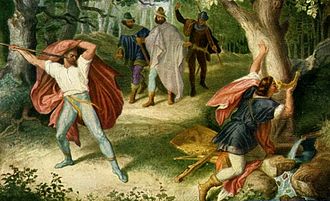
Back أسطورة الطعنة في الظهر Arabic Lleenda de la puñalada pel costazu AST Легенда за удар с нож в гърба Bulgarian Dolchstoßlegende Breton Llegenda de la punyalada per l'esquena Catalan Mýtus dýky v zádech Czech Dolkestødslegenden Danish Dolchstoßlegende German Μύθος της πισώπλατης μαχαιριάς Greek Leyenda de la puñalada por la espalda Spanish


The stab-in-the-back myth (German: Dolchstoßlegende, pronounced [ˈdɔlçʃtoːsleˌɡɛndə] ⓘ, lit. 'dagger-stab legend')[a] was an antisemitic conspiracy theory that was widely believed and promulgated in Germany after 1918. It maintained that the Imperial German Army did not lose World War I on the battlefield, but was instead betrayed by certain citizens on the home front – especially Jews, revolutionary socialists who fomented strikes and labour unrest,[1] and republican politicians who had overthrown the House of Hohenzollern in the German Revolution of 1918–1919. Advocates of the myth denounced the German government leaders who had signed the Armistice of 11 November 1918 as the "November criminals" (Novemberverbrecher).
When Adolf Hitler and the Nazi Party rose to power in 1933, they made the conspiracy theory an integral part of their official history of the 1920s, portraying the Weimar Republic as the work of the "November criminals" who had "stabbed the nation in the back" in order to seize power. Nazi propaganda depicted Weimar Germany as "a morass of corruption, degeneracy, national humiliation, ruthless persecution of the honest 'national opposition'—fourteen years of rule by Jews, Marxists, and 'cultural Bolsheviks', who had at last been swept away by the National Socialist movement under Hitler and the victory of the 'national revolution' of 1933".[2]
Historians inside and outside of Germany, whilst recognising that economic and morale collapse on the home front was a factor in German defeat, unanimously reject the myth. Historians and military theorists point to lack of further Imperial German Army reserves, the danger of invasion from the south, the overwhelming of German forces on the western front by more numerous Allied forces particularly after the entrance of the United States into the war, as evidence that Germany had already lost the war militarily by late 1918.[3][4]
Cite error: There are <ref group=lower-alpha> tags or {{efn}} templates on this page, but the references will not show without a {{reflist|group=lower-alpha}} template or {{notelist}} template (see the help page).
- ^ Kershaw 2016, pp. 118–119.
- ^ Kolb, Eberhard (2005). The Weimar Republic. New York: Routledge. p. 140. ISBN 0415344425.
- ^ Watson, Alexander (2008). Enduring the Great War: Combat, Morale and Collapse in the German and British Armies, 1914–1918. Cambridge: Cambridge Military Histories. ch. 6. ISBN 9780521881012.
- ^ Evans 2003, p. 150.
© MMXXIII Rich X Search. We shall prevail. All rights reserved. Rich X Search